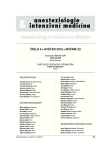Trefoil factor 1 as an indicator of damage of the intestinal mucosa during sepsis in children
Authors:
Žurek Jiří 1,2; Klučková Kateřina 1; Fedora Michal 1,2
Authors‘ workplace:
Klinika dětské anesteziologie a resuscitace LF MU Brno, FN Brno, Lékařská fakulta, Masarykova univerzita, Brno
1; Klinika dětské anesteziologie a resuscitace, Fakultní nemocnice Brno
2
Published in:
Anest. intenziv. Med., 23, 2012, č. 2, s. 83-90
Category:
Intensive Care Medicine - Original Paper
Overview
Objective:
The aim of this study was to determine the levels of TFF1 in paediatric patients with SIRS or a septic condition compared with healthy population levels. The second goal was to compare the levels of TFF1 within the individual septic conditions and the impact of this protein levels on mortality.
Design:
Prospective observational study.
Setting:
Department of Anaesthesiology and Intensive Care Medicine, University Hospital.
Materials and methods:
The study included 57 children aged 0–19 years (30 boys and 27 girls), hospitalized from June 2009 to March 2011, with expected or proven SIRS and a septic condition. The degree of severity was evaluated according to PELOD Score. Blood tests to determine TFF factor levels were taken throughout the period when the patients were meeting the SIRS or sepsis criteria. The control samples were obtained by collecting serum TFF levels from patients undergoing elective surgery.
Results:
TFF1 levels in patients with SIRS or any septic condition were higher than in the control group. TFF1 cut-off for the first day was 2.44 ng/ml, AUC 0.668, p = 0.002, for the third day 1.82 ng/ml, AUC 0.733, p < 0.001 and for the fifth day 1.33 ng/ml, AUC 0.749, p < 0.001.
TFF1 levels in patients with septic shock/MODS were higher than in other groups (p =0.038), but without apparent dynamics of this protein within five days.
Patients who were hospitalized for more than 10 days had significantly higher levels of TFF1, p = 0.032.
Conclusion:
We demonstrated increased expression of protein Trefoil factor 1 during sepsis in the paediatric population.
Keywords:
sepsis – trefoil factor 1 – gut – children – mortality
Sources
1. Watson, R. S., Carcillo, J. A. Scope and epidemiology of pediatric sepsis. Pediatr. Crit. Care Med., 2005, 6, 3, Suppl S3–5.
2. Thuijls, G., Derikx, J. P. M., Grootjans, J., Busurman, W. A., van Waardenburg, D. A. Intestinal barrier loss in sepsis. Neth. J. Crit. Care, 2011, 15, 4, p. 199–203.
3. Rösler, S., Haase, T., Claassen, H., Schulze, U., Schicht, M., Riemann, D., Brandt, J., Wohlrab, D., Müller--Hilke, B., Goldring, M. B., Sel, S., Varoga, D., Garreis, F., Paulsen, F. P. Trefoil factor 3 is induced during degenerative and inflammatory joint disease, activates matrix metalloproteinases, and enhances apoptosis of articular cartilage chondrocytes. Arthritis Rheum., 2010, 62, 3, p. 815–825.
4. Wright, N. A., Hoffmann, W., Otto, W. R., Rio, M. C., Thim, L. Rolling in the clover: trefoil factor family (TFF)-domain peptides, cell migration and cancer. FEBS Letters., 1997, 408, 2, p. 121–123.
5. Hoffmann, W., Jagla, W., Wiede, A. Molecular medicine of TFF-peptides: from gut to brain. Histol. Histopathol., 2001, 16, 1, p. 319–334.
6. Soutto, M., Belkhiri, A., Piazuelo, M. B., Schneider, B. G., Peng, D., Jiang, A., Washington, M. K., Kokoye, Y., Crowe, S. E., Zaika, A., Correa, P., Peek, R. M. Jr., El-Rifai, W. Loss of TFF1 is associated with activation of NF-κB-mediated inflammation and gastric neoplasia in mice and humans. J. Clin. Invest., 2011, 121, 5, p. 1753–1767.
7. Bossenmeyer-Pourié, C., Kannan, R., Ribieras, S., Wendling, C., Stoll, I., Thim, L., Tomasetto, C., Rio, M. C. The trefoil factor 1 participates in gastrointestinal cell differentiation by delaying G1-S phase transition and reducing apoptosis. J. Cell Biol., 2002, 157, 5, p. 761-770.
8. Goldstein, B., Giroir, B., Randolph, A. International Consensus Conference on Pediatric Sepsis. International pediatric sepsis consensus conference: definitions for sepsis and organ dysfunction in pediatrics. Pediatr. Crit. Care Med., 2005, 6, 1, p. 2–8.
9. Leteurtre, S., Martinot, A., Duhamel, A., Gauvin, F., Grandbastien, B., Nam, T. V., Proulx, F., Lacroix, J., Leclerc, F. Development of a pediatric multiple organ dysfunction score: use of two strategies. Med. Decis. Making, 1999, 19, 4, p. 399–410.
10. Rowlands, B. J., Gardiner, K. R. Nutritional modulation of gut inflammation. Proc. Nutr. Soc., 1998, 57, p. 395–401.
11. Rowlands, B. J., Soong, C. V., Gardiner, K. R. The gastrointestinal tract as a barrier in sepsis. British Medical Bulletin, 1999, 55, 1, p. 196–211.
12. Derikx, J. P., Poeze, M., van Bujněn, A. A., Busurman, W. A., Heineman, E. Evidence for intestina and liver epithelial cell injury in the early phase of sepsis. Shock, 2007, 28, p. 544–548.
13. Derikx, J., Bojler, E., Vos, G., Bujněn, A. A., Heineman, E., Busurman, W. et al. Gut mucosal cell damage in meningococcal sepsis in children: relation with clinical outcome. Crit. Care Med., 2010, 38, p. 133–137.
14. Nieuwenhuijzen, G. A., Goris R. J. The gut: the ‘motor’ of multiple organ dysfunction syndrome? Curr. Opin. Clin. Nutr. Metab. Care, 1999, 2, 5, p. 399–404.
15. Derikx, J. P., Matthijsen, R. A., de Bruine, A. P., van Bijnen, A. A., Heineman, E., van Dam, R. M. et al. Rapid reversal of human intestinal ischemia-reperfusion induced damage by shedding of injured enterocytes and reepithelialisation. PLoS One, 2008, 3, e3428.
Labels
Anaesthesiology, Resuscitation and Inten Intensive Care MedicineArticle was published in
Anaesthesiology and Intensive Care Medicine

2012 Issue 2
Most read in this issue
- Validation of factors predicting difficult intubation
- Quality of life one year after discharge from the ICU
- A severe course of acquired haemophilia A – case report
- An audit of the i-gel supraglottic airway for general anaesthesia with spontaneous and controlled ventilation – the effect of ventilation mode and operator experience on device performance
